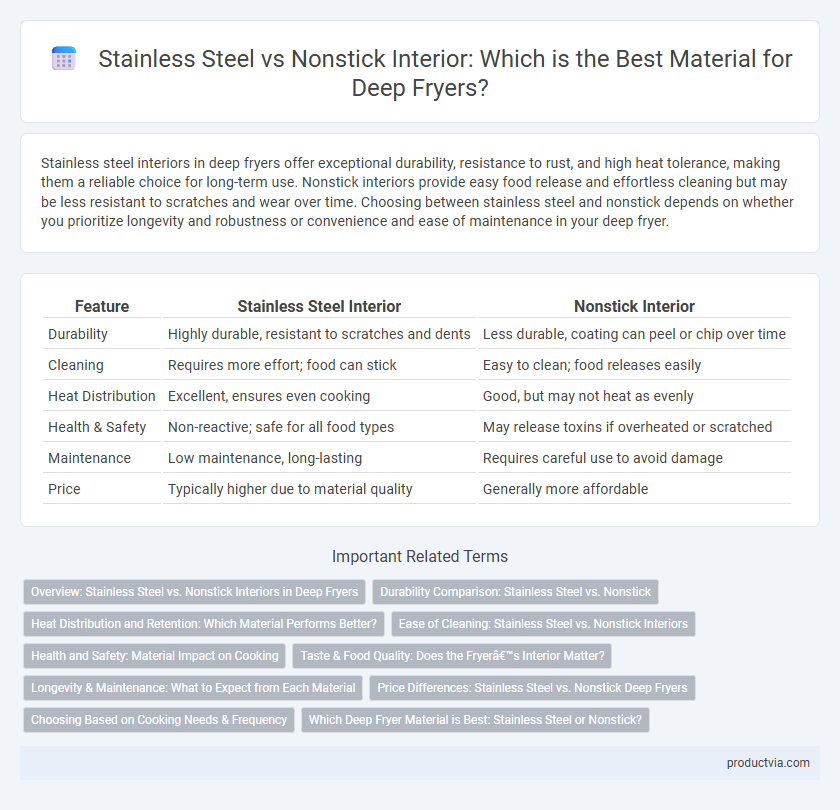Stainless steel interiors in deep fryers offer exceptional durability, resistance to rust, and high heat tolerance, making them a reliable choice for long-term use. Nonstick interiors provide easy food release and effortless cleaning but may be less resistant to scratches and wear over time. Choosing between stainless steel and nonstick depends on whether you prioritize longevity and robustness or convenience and ease of maintenance in your deep fryer.
Table of Comparison
| Feature | Stainless Steel Interior | Nonstick Interior |
|---|---|---|
| Durability | Highly durable, resistant to scratches and dents | Less durable, coating can peel or chip over time |
| Cleaning | Requires more effort; food can stick | Easy to clean; food releases easily |
| Heat Distribution | Excellent, ensures even cooking | Good, but may not heat as evenly |
| Health & Safety | Non-reactive; safe for all food types | May release toxins if overheated or scratched |
| Maintenance | Low maintenance, long-lasting | Requires careful use to avoid damage |
| Price | Typically higher due to material quality | Generally more affordable |
Overview: Stainless Steel vs. Nonstick Interiors in Deep Fryers
Stainless steel interiors in deep fryers offer superior durability, resistance to high temperatures, and ease of cleaning without worrying about surface scratching or peeling. Nonstick interiors provide quick food release and easier oil residue removal but may degrade over time with frequent use or metal utensil contact. Choosing between stainless steel and nonstick depends on prioritizing long-term durability versus convenience in maintenance and cooking performance.
Durability Comparison: Stainless Steel vs. Nonstick
Stainless steel interiors in deep fryers offer superior durability, resisting scratches, dents, and high-temperature corrosion better than nonstick coatings. Nonstick interiors, while convenient for easy cleaning, tend to degrade over time due to peeling or chipping from frequent use and metal utensils. Choosing stainless steel ensures long-lasting performance and maintains structural integrity under rigorous frying conditions.
Heat Distribution and Retention: Which Material Performs Better?
Stainless steel interiors in deep fryers offer superior heat retention and even heat distribution, ensuring consistent cooking temperatures and preventing hotspots. Nonstick coatings, while convenient for easy cleaning, typically conduct heat less evenly and may degrade over time, affecting performance. For optimal heat management and durability, stainless steel interiors generally outperform nonstick alternatives in deep fryer applications.
Ease of Cleaning: Stainless Steel vs. Nonstick Interiors
Stainless steel interiors in deep fryers offer durability and resistance to staining but can require more effort to clean due to food sticking and potential discoloration. Nonstick interiors provide superior ease of cleaning by preventing food adhesion, allowing quick wipe-downs and less scrubbing. Choosing between stainless steel and nonstick depends on balancing long-term durability against convenience in maintenance.
Health and Safety: Material Impact on Cooking
Stainless steel interiors in deep fryers offer superior durability and resistance to corrosion, ensuring no harmful chemicals leach into food during high-temperature cooking. Nonstick coatings, while preventing food from sticking and easing cleanup, may release toxic fumes when overheated, posing potential health risks. Choosing stainless steel prioritizes long-term safety and maintains food purity by avoiding chemical exposure during frying.
Taste & Food Quality: Does the Fryer’s Interior Matter?
Stainless steel interiors in deep fryers provide superior heat retention and even cooking, which enhances the texture and flavor of fried foods by preventing hot spots and ensuring consistent browning. Nonstick coatings, while easier to clean, may release chemicals at high temperatures that can subtly alter food taste and do not produce the same crispiness due to less efficient heat conduction. Choosing stainless steel interiors ensures better flavor preservation and optimal food quality for deep-fried dishes.
Longevity & Maintenance: What to Expect from Each Material
Stainless steel deep fryer interiors offer superior durability and resistance to scratching, ensuring long-term use without degradation in cooking performance. Nonstick interiors provide easy cleanup and require less oil for cooking, but their coatings may wear off over time, reducing lifespan and necessitating careful maintenance. Choosing stainless steel guarantees longevity with minimal maintenance, while nonstick interiors prioritize convenience at the expense of durability.
Price Differences: Stainless Steel vs. Nonstick Deep Fryers
Stainless steel deep fryers typically come with a higher price tag due to their durability, resistance to corrosion, and professional-grade build quality. Nonstick interior deep fryers are generally more affordable, appealing to budget-conscious consumers seeking easier cleaning and less oil absorption. Consumers should weigh long-term investment benefits of stainless steel against the cost-effectiveness and convenience offered by nonstick options.
Choosing Based on Cooking Needs & Frequency
Stainless steel interiors for deep fryers offer superior durability and resistance to scratches, making them ideal for frequent use and high-temperature cooking. Nonstick interiors provide easier cleaning and require less oil, suited for occasional frying and healthier meal preparation. Selecting the appropriate material depends on cooking frequency and maintenance preference, balancing longevity with convenience.
Which Deep Fryer Material is Best: Stainless Steel or Nonstick?
Stainless steel deep fryer interiors offer superior durability, resistance to scratches, and maintain their appearance over time, making them ideal for heavy use and frequent cleaning. Nonstick interiors provide easy food release and faster cleanup but may degrade with high heat exposure and abrasive utensils, reducing longevity. Choosing the best material depends on balancing the need for durability and ease of maintenance, where stainless steel excels in longevity and nonstick prioritizes convenience.
Stainless Steel vs Nonstick Interior for deep fryer material Infographic

 productvia.com
productvia.com